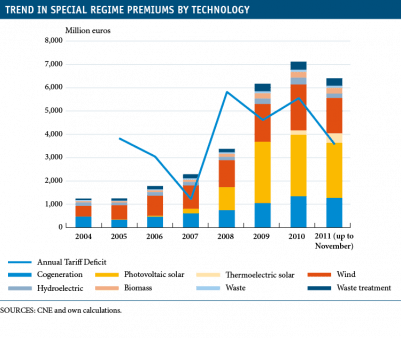The regulation of Spain's electricity sector has been the focus of discussion for several years, mainly regarding how the transition has been carried out from a vertically integrated monopoly to another model in which regulated segments (transmission and distribution) exist side by side with more competitive segments (generation and sale). In addition to the problem of guaranteeing the supply of electricity to consumers and firms at a reasonable price, the need to minimise the negative environmental impact of energy production has also arisen over the last few years. Following the strategy agreed with the rest of Europe, Spain has decided to reduce its energy dependence and emissions of pollutants by increasing the share of renewable energy sources in producing electricity, setting a target of 38.2% by 2020.(1) This target takes into account not only Spain's great potential in terms of renewable resources but also industrial policy considerations, such as the benefits that can be derived from leading research into such vital sectors for the future. However, achieving this target involves a significant change in the generation mix of the Spanish market, something that, far from easing controversy, presents even greater challenges for the sector's regulatory policy over the coming years.
The first of these challenges is due to the method chosen to encourage investment in these technologies. As in most European Union countries, Spain has chosen to ensure an appropriate return for this investment by setting the wholesale price for the energy produced. More specifically, generators can choose between selling at a regulated tariff that is different for each technology or selling at a free price on the wholesale market plus a premium, which varies according to the technology and the market's hourly prices. Taking into account the fact that 7 renewable technologies are currently being employed, it is quite complicated to set rates in such a way as to ensure the desired generation targets are achieved at a minimal cost.
On the one hand, this should take into account the fact that the currently high costs of renewables will fall every year as the experience acquired through producing electricity leads to technological improvements. Consequently, in order to ensure these are encouraged at the minimum possible cost, the regulator must determine the optimal annual production path and therefore the volume of premiums required to achieve it, given its expectations regarding this learning curve and the trend in input prices for the rest of the non-renewable generators (oil, gas and CO2 emission rights). On the other hand, setting tariffs and premiums for each renewable technology requires an implicit decision regarding the best combination of these technologies. Any error in the predictions of the relevant variables might not only result in an excessive cost for encouraging renewable energies but might also lead to overinvestment in some, making the mix of renewables less efficient than it could be.
A recent study by IESE(2) suggests that such errors might have been made in the Spanish case in the system applied up to 2009, worsened by the fact that no limit was established to the renewable production that could come under the tariff and premium system each year. As can be seen in the graph below, the equivalent premium (the sum of the compensation received via tariffs and via premiums) grew exponentially between 2008 and 2010. This is mainly due to the high remuneration established in 2007 for photovoltaic solar technology and the unexpected fall in wholesale prices, resulting from the low demand for electricity since the crisis. The study estimates that these premiums value the CO2 emissions avoided in 2009 thanks to renewable energy at around 250 euros/tonne, when emission allowances are currently worth 15 euros/tonne and are expected to remain between 30 and 50 euros/tonne in 2020. It's true that the price of CO2 is too low, due to problems with how emissions trading works, and that it probably does not measure environmental costs accurately. However, the large number of photovoltaic firms that have emerged over the last few years, much more than the targets set, does indicate that these targets could have still been achieved at lower premiums.
Although various royal decrees passed since 2009 have attempted to correct the design of the renewable scheme, the problem of the probable excess cost incurred is difficult to resolve without creating some legal uncertainty due to the long duration of the premiums promised (between 20 and 25 years). To this we must add the fact that, a priori, the cost of promoting renewables should be passed on to the end consumer via the regulated access and last resort tariffs. However, these are not enough to cover the system's transmission and distribution costs once this volume of premiums has been met. The consequence is a rise in the tariff deficit, which is borne by electricity distributors and swells the state debt burden through the FADE Fund.
Another of the challenges faced is the interaction of renewables support policies with policies to aid domestic coal. A low demand since the crisis and the growing contribution of renewables to the wholesale market are pushing coal-fired power plants, normally the least competitive, out of the market. This fact, although coherent with the regulator's environmental aims, is contrary to the aim of helping disadvantaged regions or sectors undergoing reconversion. The latter, curiously, are being accomplished through intervention in the electricity market. Royal Decree 134/2010 has modified the order of economic merit used to establish electricity prices in the wholesale market, replacing the production of other, more efficient fossil fuel power plants with production by domestic coal-fired power plants. Moreover, minimum amounts of coal have been set that must be acquired by the plants, also at a regulated price. The result is that correct price formation in the wholesale market has been distorted, producing erroneous signals for investment in sufficiently flexible generation technologies (such as combined cycle) which will be required with the growth in renewables.
This last point is precisely another of the challenges facing the regulator. The relatively low variable cost of many renewable energy sources make them ideal to provide the system with basic capacity. However, the intermittent nature of their production, subject to weather conditions, prevents them from being able to meet inopportune peaks in demand. These will have to be met by plants with flexible technologies, whose variable cost is higher and with little possibility of taking part in the market during normal periods. Given that these plants must also cover their fixed costs and achieve a reasonable return, the regulator will have to adjust capacity payments in order to preserve these firms' investment incentives. If not, it will run the risk of high end prices during peaks or abusive conduct on the part of these flexible power plants. To minimize this, and as a complementary measure, it is vital to ensure there are alternative mechanisms to cover these peaks in demand. Among these are energy storage technologies and improvements in management and prediction systems for renewables in order to improve their combined performance.
In summary, there are many variables that must be taken into account by the regulator to find the right policy for the electricity market. It would therefore be reasonable to wonder whether another mechanism could have been adopted in order to boost renewables that is less information intensive. Whatever the case, we need to eliminate the distortions and complications added by targets that do not follow purely environmental, efficiency or energy security criteria. Regulating the industry will not be such a challenge if alternative mechanisms are found to meet these criteria.
(1) The target is 38% of gross electricity production according to the Renewable Energy Plan (PER 2011-2020) and 36% according to the National Action Plan for Renewable Energy (PANER 2011-2020).
(2) Federico, G. (2010), The Spanish Gas and Electricity Sector: Regulation, Markets and Environmental Policies, Reports of the Public-Private Sector Research Center, IESE Business School.
This box was prepared by Sandra Jodar-Rosell
Economic Analysis Unit, Research Department, "la Caixa"


